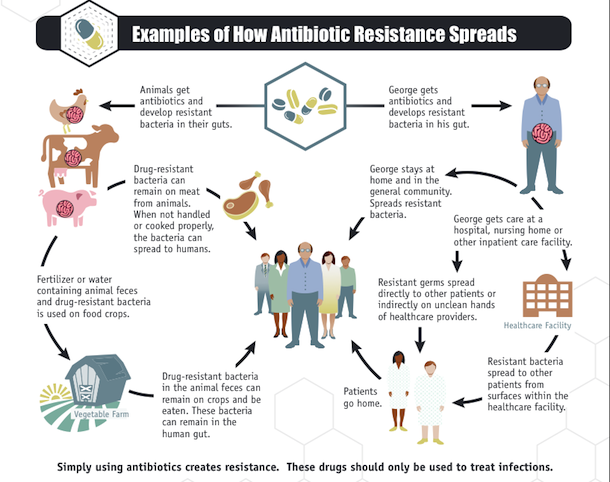CDC: 2 Million Americans Get Sick From Antibiotic-Resistant Infections Every Year
 While livestock farmers around the country continue to feed medically unnecessary antibiotics to their animals for the sole purpose of encouraging growth, millions of Americans are falling ill — and thousands dying — every year from bacterial and fungal infections that are resistant to current medication, claims a new report from the Centers for Disease Control.
While livestock farmers around the country continue to feed medically unnecessary antibiotics to their animals for the sole purpose of encouraging growth, millions of Americans are falling ill — and thousands dying — every year from bacterial and fungal infections that are resistant to current medication, claims a new report from the Centers for Disease Control.
In the latest Threat Report [PDF] from the CDC, it conservatively estimates that more than 2 million Americans fall ill every year from some sort of drug-resistant bacteria or fungus, resulting in around 23,000 deaths.
Similarly, CDC figures that 250,000 Americans are hospitalized every year with infection from Clostridium difficile, a bacterium that is not in itself overly drug-resistant, but whose presence is an indicator of antibiotic use and resistance. Of the quarter-million people hospitalized every year for Clostridium difficile infections, the CDC estimates 14,000 die.
“Antibiotic-resistant infections add considerable and avoidable costs to the already overburdened U.S. healthcare system,” writes the CDC in the report. “In most cases, antibiotic-resistant infections require prolonged and/or costlier treatments, extend hospital stays, necessitate additional doctor visits and healthcare use, and result in greater disability and death compared with infections that are easily treatable with antibiotics.
Some estimate that the additional immediate healthcare costs due to drug-resistant infections is as much as $20 billion a year. On top of that, the loss of productivity from people who become ill each year could be as high as $35 billion annually.
Antibiotic resistance is, like the diseases antibiotics are intended to curb, spreading globally, from person to person and in the food supply. And the mere use of antibiotics is, per the CDC, the “single most important factor leading to antibiotic resistance around the world.”
While physicians can, and should, be more judicious in their prescribing of antibiotics, they will still be needed to treat ill people. But a significant portion of the antibiotics being used can be stopped by simply removing it from livestock animal feed, where it is not being used to treat sick animals, but to encourage tissue growth.
“The use of antibiotics for promoting growth is not necessary,” writes the CDC, “and the practice should be phased out… It is difficult to directly compare the amount of drugs used in food animals with the amount used in humans, but there is evidence that more antibiotics are used in food production.”
Some estimates claim that non-medical use on livestock animals accounts for around 80% of the antibiotic sales in the U.S. Thus, cutting out the left half of the diagram above, along with more careful prescribing of antibiotics for humans, would have a huge impact on the spread of drug-resistant superbugs, concludes the CDC:
“Up to half of antibiotic use in humans and much of antibiotic use in animals is unnecessary and inappropriate and makes everyone less safe. Stopping even some of the inappropriate and unnecessary use of antibiotics in people and animals would help greatly in slowing down the spread of resistant bacteria.”
“The widespread use and abuse of antibiotics is making these critical medications less effective for treating infectious diseases,” said John Santa, M.D., M.P.H., medical director of Consumer Reports Health. “Failing to curb the unnecessary use of antibiotics will result in catastrophic consequences for public health.”
Our pals at Consumers Union have repeatedly called on supermarket chains to put an end to the use of meat from animals fed antibiotics. There have also been legislative measures attempted in the U.S. House and Senate, though none have been successful so far thanks to massive amounts of lobbying by the agricultural and pharmaceutical industries, which claim that all the science that has repeatedly tied drugs in animal feed to an increase in drug-resistant bacteria just isn’t there.
Want more consumer news? Visit our parent organization, Consumer Reports, for the latest on scams, recalls, and other consumer issues.

